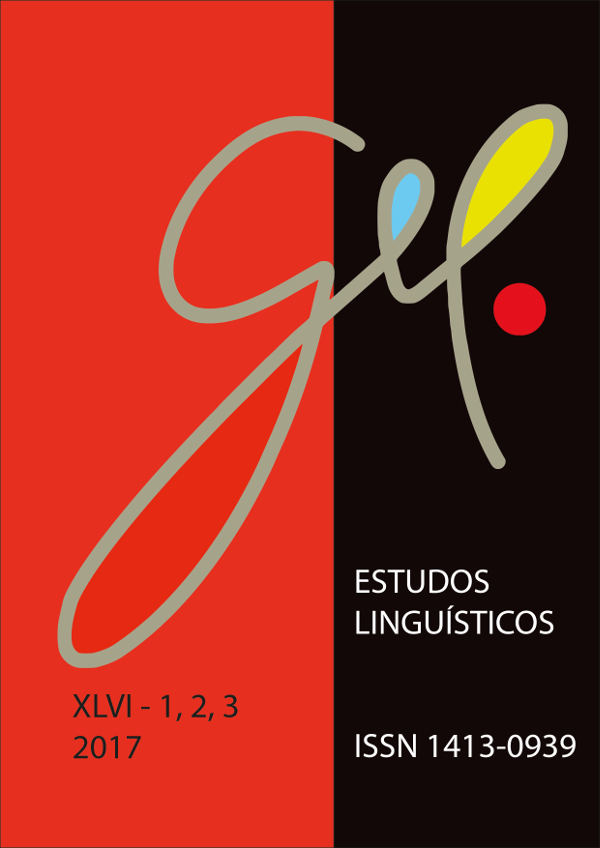The construction "na hora que" [by the time] from the variationist Sociolinguistic perspective
DOI:
https://doi.org/10.21165/el.v46i1.1626Keywords:
sociolinguística variacionista, mudança linguística, construcionalizaçãoAbstract
Based on the variationist Sociolinguistic view (LABOV, 2008; WEINREICH; LABOV; HERZOG, 1968), this article aims to investigate, between the different forms of na hora que [by the time] (na hora em que [by the time that], na hora que, a hora que, hora que [when]), whether there is a defined sociolinguistic distribution, characterizing a variable phenomenon in the Labov’s sense, or if the use of these different forms only reflects a phonetic reduction (LEHMANN, 1982; HEINE et al., 1991) that affects the phrase in constructionalization (TRAUGOTT; TROUSDALE, 2013). For the data analysis, extracted from the Iboruna database, four social factors were considered: gender, age, education level and family income of the interviewee. The results showed no significant sociolinguistic differences between the forms, but there are evidences that these forms are micro-constructions in changing process.Downloads
References
ALKMIM, T. M. Sociolinguística: parte 1. In: MUSSALIN, F.; BENTES, A. C. Introdução à linguística: domínios e fronteiras. v. 1. 9. ed. São Paulo: Cortez, 2012. p. 23-50.
BRAGA, M. L. As orações de tempo sob uma perspectiva funcionalista. In: RODRIGUES, A. C. S.; ALVES, I. M.; GOLDSTEIN, N. S. (Org.). I Seminário de Filologia e Língua Portuguesa. São Paulo: Humanitas, 1999a. p. 97-108.
______. Os Enunciados de Tempo no Português Falado no Brasil. In: NEVES, M. H. M. (Org.). Gramática do Português Falado. v. VII: Novos Estudos. São Paulo: Editora da UNICAMP, 1999b. p. 443-459.
______. Os Enunciados de Tempo no Português de Contato. Letras de Hoje, PUC-RS, v. 3, p. 7-18, 2001a.
______. Processos de combinação de orações: enfoques Funcionalistas e Gramaticalização. Scripta, Belo Horizonte: PUC-MG, v. 5, n. 9, p. 23-34, 2001b.
CAMACHO, R. G. A variação linguística. In: São Paulo (Estado) SE/CENP. Subsídios à proposta Curricular de Língua Portuguesa para o 1º e o 2º Graus (Coletânea de textos). v. 1. São Paulo, SE/CENP/UNICAMP, 1988. p. 29-41.
______. Sociolinguística: parte 2. In: MUSSALIN, F.; BENTES, A. C. Introdução à linguística: domínios e fronteiras. v. 1. 9. ed. São Paulo: Cortez, 2012. p. 51-83.
______. Da linguística formal à linguística social. São Paulo: Parábola, 2013.
CHAMBERS, J. K.; TRUDGILL, P. Dialectology. Cambridge: Cambridge University Press, 1980.
CROFT, W. Radical construction grammar: Syntactic theory in typological perspective. Oxford: Oxford University Press, 2001.
GOLDBERG, A. E. Constructions: a construction grammar approach to argument structure. Chicago: University of Chicago Press, 1995.
______. Constructions at work. The nature of generalization in language. Oxford: Oxford University Press, 2006.
HEINE, B.; CLAUDI, U.; HÜNNEMEEYER, F. Grammaticalization: a conceptual framework. London: University Chicago Press, 1991.
HOPPER, P. On some principles in the grammaticalization. In: TRAUGOTT, E.; HEINE, B. (Ed.). Approaches to grammaticalization. Philadelphia: John Benjamins, 1991. v. 1. p. 17-35.
HEINE, B.; TRAUGOTT, E. Grammaticalization. Cambridge: Cambridge University Press, 1993.
LABOV, W. Principles of linguistic change: internal factors. Cambridge: Blackwell, 1994.
______. Constructions at work. The nature of generalization in language. Oxford: Oxford University Press, 2006.
______. O estudo da língua em seu contexto social. In: ______. Padrões sociolinguísticos. Tradução de Marcos Bagno et al. São Paulo: Parábola, 2008. p. 215-299.
LEHMANN, C. Towards a typology of clause linkage. In: HAIMAN, J.; THOMPSON, S. A. Clause combining in grammar and discourse. Amsterdam: John Benjamins Publishing, 1982.
LIMA-HERNANDES, M. C. Orações adverbiais temporais conectivas no português popular de São Paulo. In: GARTNER, E.; HUNDT, C.; SCHÖNBERG, A. (Org.). Estudos de sociolingüística portuguesa. Frankfurt am Main: TFM, 2000. p. 74-75.
______. Estágios de gramaticalização da noção de tempo – processos de combinação de orações. Veredas, v. 8, n. 1 e 2, p. 183-194, 2004.
MEILLET, A. L’évolution des formes grammaticales. In: MEILLET, A. Linguistique Historique et Linguistique Générale. Paris: Champion, 1948. p. 130-148.
NEVES, M. H. M. Conectar significados. Ou: A formação de enunciados complexos. In: ______. Texto e gramática. São Paulo: Contexto, 2007. p. 223-269.
OLIVEIRA, M. R. Tendências atuais da pesquisa funcionalista. In: SOUZA, E. R. (Org.). Funcionalismo Linguístico: novas tendências teóricas. São Paulo: Contexto, 2012. p. 133-152.
______. Gramaticalização de construções como tendência atual dos estudos funcionalistas. Estudos Linguísticos, v. 42, n. 1, p. 148-162, 2013.
SANKOFF, D.; SMITH, E.; TAGLIAMONTE, S. A. Goldvarb X: A variable rule application for Macintosh and Windows. Toronto: Department of Linguistics, University of Toronto, 2005.
TARALLO, F. A pesquisa sociolinguística. São Paulo: Ática, 1985.
TRAUGOTT, E. C. Toward a coherent account of grammatical constructionalization. To appear in: SMIRNOVA, E.; BARÐDAL, J.; GILDEA, S.; SOMMERER, L. (Ed.). Historical Construction Grammar. 2012. Disponível em: <http://pt.scribd.com/doc/150342997/Traugott-2012>. Acesso em: 10 jun. 2015.
TRAUGOTT, E. C.; TROUSDALE, G. Constructionalization and Constructional Changes. Oxford: Oxford University Press, 2013.
WEINREICH, U.; LABOV, W.; HERZOG, M. A língua como um sistema diferenciado. In: ______. Fundamentos empíricos para uma teoria da mudança linguística. Tradução de Marcos Bagno; revisão de Carlos Alberto Faraco. São Paulo: Parábola, 2006.



